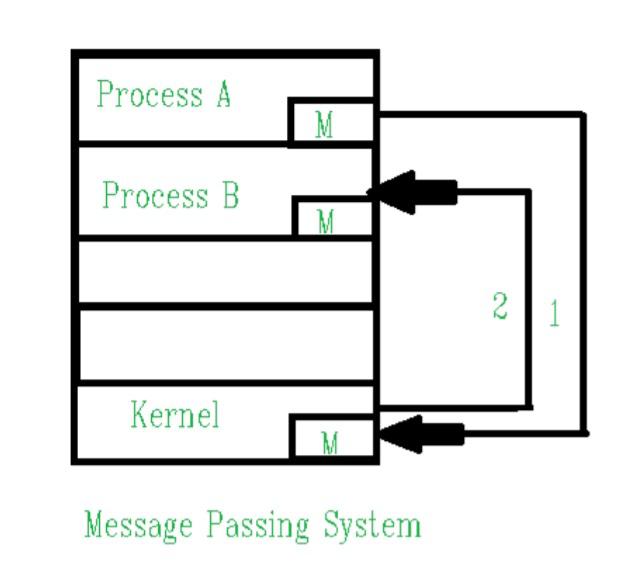Message Passing in Distributed System
Last Updated :
29 Jun, 2023
Message passing in distributed systems refers to the communication medium used by nodes (computers or processes) to commute information and coordinate their actions. It involves transferring and entering messages between nodes to achieve various goals such as coordination, synchronization, and data sharing.
Message passing is a flexible and scalable method for inter-node communication in distributed systems. It enables nodes to exchange information, coordinate activities, and share data without relying on shared memory or direct method invocations. Models like synchronous and asynchronous message passing offer different synchronization and communication semantics to suit system requirements. Synchronous message passing ensures sender and receiver synchronization, while asynchronous message passing allows concurrent execution and non-blocking communication.

Types of Message Passing
- Synchronous message passing
- Asynchronous message passing
- Hybrids
1. Synchronous Message Passing
Synchronous message passing is a communication mechanism in existing programming where processes or threads change messages in a synchronous manner. The sender blocks until the receiver has received and processed the message, ensuring coordination and predictable execution. This approach is generally enforced through blocking method calls or procedure invocations, where a process or thread blocks until the called system returns a result or completes its prosecution. This blocking behavior ensures that the caller waits until the message is processed before proceeding. However, synchronous message passing has potential downsides, such as delays or halts in the system if the receiver takes too long to process the message or gets stuck. To ensure the proper functioning of synchronous message passing in concurrent systems, it’s crucial to precisely design and consider potential backups and error handling.
2. Asynchronous Message Passing
Asynchronous message passing is a communication mechanism in concurrent and distributed systems that enables processes or factors to change messages without demanding synchronization in time. It involves sending a message to a receiving process or component and continuing execution without waiting for a response. Key characteristics of asynchronous message passing include its asynchronous nature, which allows the sender and receiver to operate singly without waiting for a response. Communication occurs through the exchange of messages, which can be one-way or include a reply address for the receiver to respond. Asynchronous message passing also allows for loose coupling between the sender and receiver, as they can be running on separate processes, threads, or different machines.
Message buffering is frequently used in asynchronous message passing, allowing the sender and receiver to operate at their own pace. Asynchronous message passing is extensively used in scenarios like distributed systems, event-driven architectures, message queues, and actor models, enabling concurrency, scalability, and fault tolerance.
3. Hybrids
Hybrid message passing combines elements of both synchronous and asynchronous message ends. It provides flexibility to the sender to choose whether to block and hold on for a response or continue execution asynchronously. The choice between synchronous or asynchronous actions can be made based on the specific requirements of the system or the nature of the communication. Hybrid message passing allows for optimization and customization based on different scenarios, enabling a balance between synchronous and asynchronous paradigms.
Conclusion
Message passing is a fundamental mechanism for communication in distributed systems. It enables processes or nodes to exchange messages and coordinate their actions. There are several types of message-passing models, including synchronous, asynchronous, and hybrid approaches. Synchronous message passing ensures deterministic and sequential execution, while asynchronous message passing allows senders to continue execution immediately without waiting for a response. Hybrid message passing combines synchronous and asynchronous paradigms, providing flexibility for senders to choose the appropriate communication mode.
FAQs on Message Passing in Distributed System
Q1: What is the difference between synchronous message passing and asynchronous message passing?
Answer:
Asynchronous message passing allows the sender to continue execution without waiting for a response, enabling simultaneous processing and separation of components. Synchronous message passing induces a blocking behavior where the sender waits for the receiver’s answer.
Q2: What is “Message Passing in Distributed System”?
Answer:
Message passing in distributed systems involves communication between nodes to coordinate actions, exchange data, and propagate information. It enables collaboration, synchronization, and sharing of information to achieve a common goal.
Q3: How many types of Message Passing are there?
Answer:
There are two types Message Passing ,they are Synchronous message passing, Asynchronous message passing .The combination of both of them is known as “hybrid”.
Q4: Difference between shared memory vs message passing?
Answer:
Shared memory communication involves multiple processes accessing shared memory for fast, efficient communication. It requires synchronization and data consistency, but may be challenging in distributed systems. Message passing, on the other hand, allows processes to send and receive messages through a communication channel, offering flexibility in designing complex patterns but introducing additional overhead.
Q5: What are the common challenges in message-passing systems?
Answer:
Some common challenges include managing message serialization and deserialization, ensuring reliable message delivery, handling message ordering and synchronization, and dealing with potential failures or network delays that can impact message transmission and reception.
Share your thoughts in the comments
Please Login to comment...